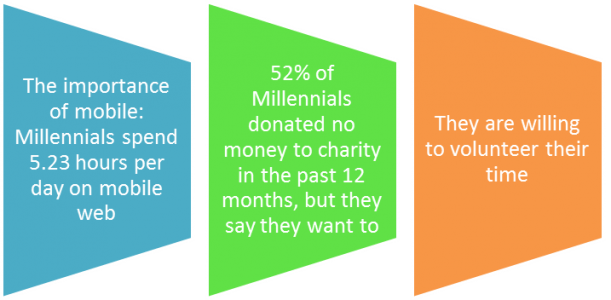Charitable giving is sometimes a tricky issue. Research shows that charitable behaviours (e.g. giving donations or volunteering) increase the wellbeing of both the giver and the receiver, it’s associated with greater life satisfaction, and comprehensively it benefits society at large. We can all agree that the UK is a generous country, having more than 150.000 charities and with a public that donated £10.6 billion to charitable causes in 2014 (Sources: Charity Aid Foundation and Behavioural Insight Team).
These figures are very positive, yet more could still be done. Especially when the charitable behaviours regard Millennials. In fact, statistics show that those aged 16 – 24 are the least likely to be involved in charitable giving or social actions. Research into charitable giving highlighted some important information in regards to Millennials attitudes towards charity donations. Here are the main points:
Figure 1. Source: GB TGI 2015
We also asked members aged 18 – 34 of our YourVoice community whether they donate their time and money to charity, which charities they support and why, and what most inspires them to donate. This is what we found:
Figure 2. Source: OMD Insight: YourVoice Oct. 2015
So there is still quite a high proportion who claim to not participate in charitable causes in any way. A few interesting points emerged:
- People have issues with transparency: “where does my money go?”
- People tend to donate for matters of personal relevance
- “I don’t have time or money to spare” (due to college or work)
- Some charities are not publicised enough for their good results
- People commonly and mistakenly believe that some charitable causes are instead governmental issues – important to communicate and emphasise when charities rely only on volunteers and donations.
So how can we increase charity donations?
Scientific research and the Behavioural Insight Team of the UK government have some ideas.
Insight 1: Make it Easy
One of the best ways to encourage people to give is to make it easy for people to do so.
- People often say that they don’t have time – so make it easy for them to get involved in charitable causes.
- Think about how technology facilitates this: for example, the initiative “Penny for London” allowing us to give donations through tapping our oyster cards, is an extremely efficient and smart way to ask people for donations.
Insight 2: Attract Attention
Attracting individuals’ attention can be a powerful way of increasing donations.
- Use personalised messages, since they are more effective than more generic ones
- Make it salient: using Cancer Research as an example, making donations through tapping our card on a shop window is engaging and salient, and it attracts people’s attention
- Other brilliant examples of attracting attention using technology include Save the Children contactless donations, Barclays contactless, and Oxfam “touch your phone on a shop window” to donate.
Insight 3: Focus On The Social
We are social animals. So we are all influenced by the actions of those around us and we are more likely to give to charity if we see it as the social ‘norm’- if we see that other people are doing it too.
- Think about peer effects, emphasising charitable giving within one’s social group
- Take advantage of different forms of social media to spread the message socially: let’s get people to tweet, share, like or post about charitable causes! Remember the success of the Ice Bucket Challenge and #nomakeupselfie.
Other things to consider when charities communicate:
- Be transparent about where the money is going. Charity : Water does it well – once a campaign is over, donors are informed about who and where exactly their money is helping
- Focus on highlighting the positive results that a charity provides: think about it at a contextual and emotional level. A great example of this is the NSPCC campaign with Alfie the Astronaut!





